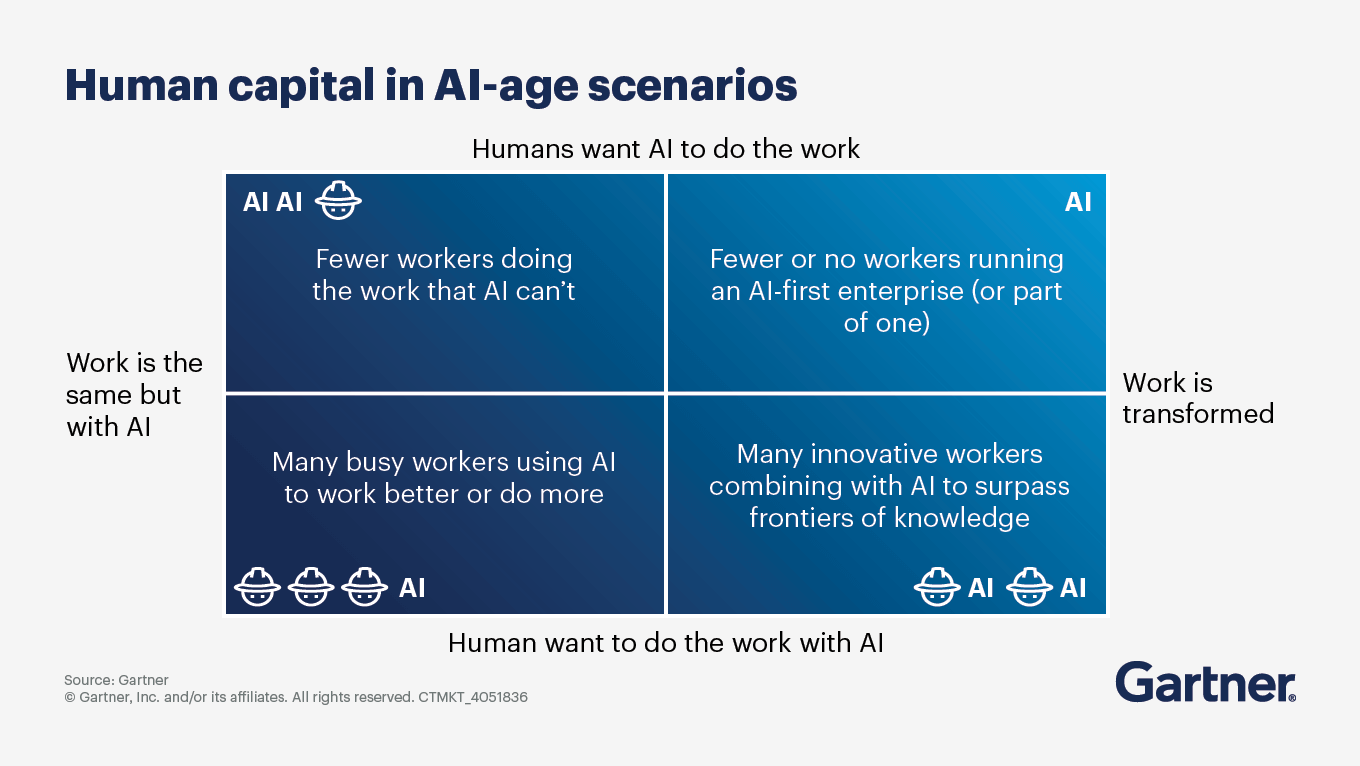Explore the four scenarios for human workers in the age of AI — and how your organization and people can plan for them.
- Gartner client? Log in for personalized search results.
Prepare for AI’s ripple effect on jobs
The decisions executive leaders make today about how to use AI — and to understand the impact of AI on jobs — will shape their organizations and workforce for years to come. Leaders need frameworks to identify blind spots and plan for both expected and unexpected effects on the workforce.
Gartner calls these impacts “ripple effects.” They occur when AI is deployed in an organization and changes how work is done — often in unexpected ways. This shift creates downstream consequences — i.e., ripple effects — on your workforce, how many people you need, what roles they play and how they work.
Prepare for AI’s ripple effect on your organization
The Gartner four-scenario framework shows how AI reshapes roles across industries. Even if you plan for one scenario — like reducing headcount as an example — ripple effects often trigger the need to support all four. That’s why leaders must prepare for multiple outcomes at once.
4 scenarios for human capital in the age of AI
The respective role of humans and AI will vary depending on two key drivers: how much autonomy the organization gives AI and how much effort goes into transforming work from what it is today.
Where a particular task, process or role falls relative to those two drivers determines which scenario it falls into, as depicted in the image at the top of this page:
Scenario 1: Fewer workers doing the work AI can’t. Humans want AI to do the work, and the work is relatively unchanged, despite efforts to maximize AI’s autonomy. In this scenario, humans fill in where AI cannot.
Scenario 2: Many busy workers use AI to work better and do more. Humans want to do the work with AI, and the work is the same, though AI is used to accomplish it.
Scenario 3: Many innovative workers collaborate with AI to surpass the frontiers of knowledge. Humans want to do the work with AI, and work transforms from what it is today. This is the realm of deep cross-disciplinary and combinatorial innovation, made
possible by AI.
Scenario 4: Few to no workers run an AI-first enterprise (or part of one). Humans want AI to do the work and work is transformed. This is the realm of autonomous business.
A thought exercise on AI’s ripple effects in customer service
To demonstrate the potential for ripple effects, consider the four scenarios in the context of an organization’s customer service function.
Many customer service operations aim to use AI to do as much work as possible. This looks like scenario 1, and it calls for reducing headcount by having customers resolve as many of their queries as possible through interactions with AI assistants or agents. If the organization is successful, possible ripple effects may include:
Scenario 2: The number of customer service reps directly serving clients goes down as the number needed to manage AI bots, assistants and agents — and ensure the AI is capable of answering an ever-growing series of questions — goes up.
Scenarios 2 and 3: Experienced reps help develop AI to answer long-tail questions, turning AI assistants into highly sophisticated exception handlers. This will change how the customer service organization operates and require consistent realignment with the brand and customer experience strategy.
Scenario 3: The human customer service role shifts to become more embedded in the design and personalization of the customer experience.
Scenario 4: A service rep (whether an AI agent or human) has a sales target.
This thought exercise demonstrates how ripple effects expand the possible impacts organizations must plan for.
Impact of AI on jobs FAQs
How is AI impacting jobs?
AI is fundamentally changing the nature of work by automating routine tasks, enhancing decision making and enabling new capabilities. These changes can affect job availability, required skills and organizational structures. As AI adoption accelerates, businesses must rethink workforce strategies to remain agile and competitive.
What are AI ripple effects, and why do they matter?
AI ripple effects are the secondary and often unexpected consequences that emerge when AI becomes the norm for performing certain tasks. These effects can reshape job roles, shift team dynamics and alter business models — sometimes in ways leaders didn’t anticipate. Understanding ripple effects helps organizations prepare for complex, multidirectional changes that go beyond simple automation.
How can the Gartner framework for anticipating AI’s impact on jobs help my organization?
The Gartner four-scenario framework helps leaders understand how artificial intelligence will reshape job roles, skills and workflows across industries. By mapping tasks and roles against two key drivers — how much autonomy is given to AI and how much it transforms the work — organizations can:
Anticipate workforce and operating model changes before they happen
Align talent strategy with AI adoption goals
Plan for multiple future scenarios, including unexpected ripple effects
Avoid blind spots in workforce planning and business operations
Attend a Conference
Accelerate growth with Gartner conferences
Gain exclusive insights on the latest trends, receive one-on-one guidance from a Gartner expert, network with a community of your peers and leave ready to tackle your mission-critical priorities.

Drive stronger performance on your mission-critical priorities.
